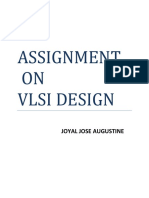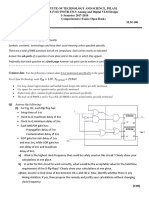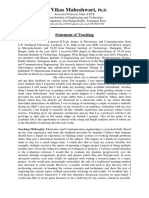0 ratings0% found this document useful (0 votes)
129 viewsAssignment1 Extended
Assignment1 Extended
Uploaded by
maheshwarivikas1982The document discusses various topics related to ADCMOS (Analog and Digital CMOS) circuits including:
1. Comparing the characteristics and threshold voltage equations of nMOS and pMOS transistors.
2. Describing the ideal and non-ideal I-V characteristics of nMOS and pMOS devices.
3. Deriving the drain current equations for MOS transistors in different operating regions and explaining second order effects.
4. Discussing CMOS process enhancements, layout design rules, and sources of power dissipation in CMOS circuits.
Copyright:
© All Rights Reserved
Available Formats
Download as PDF, TXT or read online from Scribd
Assignment1 Extended
Assignment1 Extended
Uploaded by
maheshwarivikas19820 ratings0% found this document useful (0 votes)
129 views1 pageThe document discusses various topics related to ADCMOS (Analog and Digital CMOS) circuits including:
1. Comparing the characteristics and threshold voltage equations of nMOS and pMOS transistors.
2. Describing the ideal and non-ideal I-V characteristics of nMOS and pMOS devices.
3. Deriving the drain current equations for MOS transistors in different operating regions and explaining second order effects.
4. Discussing CMOS process enhancements, layout design rules, and sources of power dissipation in CMOS circuits.
Original Description:
question bank
Original Title
Assignment1_extended
Copyright
© © All Rights Reserved
Available Formats
PDF, TXT or read online from Scribd
Share this document
Did you find this document useful?
Is this content inappropriate?
The document discusses various topics related to ADCMOS (Analog and Digital CMOS) circuits including:
1. Comparing the characteristics and threshold voltage equations of nMOS and pMOS transistors.
2. Describing the ideal and non-ideal I-V characteristics of nMOS and pMOS devices.
3. Deriving the drain current equations for MOS transistors in different operating regions and explaining second order effects.
4. Discussing CMOS process enhancements, layout design rules, and sources of power dissipation in CMOS circuits.
Copyright:
© All Rights Reserved
Available Formats
Download as PDF, TXT or read online from Scribd
Download as pdf or txt
0 ratings0% found this document useful (0 votes)
129 views1 pageAssignment1 Extended
Assignment1 Extended
Uploaded by
maheshwarivikas1982The document discusses various topics related to ADCMOS (Analog and Digital CMOS) circuits including:
1. Comparing the characteristics and threshold voltage equations of nMOS and pMOS transistors.
2. Describing the ideal and non-ideal I-V characteristics of nMOS and pMOS devices.
3. Deriving the drain current equations for MOS transistors in different operating regions and explaining second order effects.
4. Discussing CMOS process enhancements, layout design rules, and sources of power dissipation in CMOS circuits.
Copyright:
© All Rights Reserved
Available Formats
Download as PDF, TXT or read online from Scribd
Download as pdf or txt
You are on page 1of 1
ADCMOS
Unit-1
1. Compare nMOS and pMOS transistor.
2. List the effect of body bias voltage.
3. Draw the DC transfer characteristics of CMOS inverter.
4. What are the different operating modes of transistor?
5. Write the threshold voltage equation for nMOS and for pMOS transistor?
6. Define body effect and write the threshold equation including the body effect.
7. Determine whether an nMOS transistor with a threshold voltage of 0.7v is operating in the
saturation region if GSV=2v and DSV=3v.
8. Summarize the equation for describing the channel length modulation effect in nMOS
transistor.
9. Why the tunneling current is higher for nMOS transistors than pMOS transistors with silica
gate?
10. Explain in detail about the
i)ideal I-V characteristics of nMOS and pMOS devices
ii) non-ideal I-V characteristics of nMOS and pMOS devices.
11. Illustrate with necessary diagrams the i) CV characteristics of CMOS
12. )Derive the drain current of MOS device in different operating regions
13. Describe in detail about second order effects in MOS transistor
14. Briefly discuss about the CMOS process enhancement and layout design rules
15. )An nMOS transistor has the following parameters: gate oxide thickness=10nm, relative
permittivity of gate oxide =3.9, electron mobility=520cm2/v-sec , threshold voltage=0.7v,
permittivity of free space=8.85x10-14F/cm and W/L=8. Calculate the drain current when
VGS=2v and VDS=1.2v and VGS=2v and VDS=2v and also compute the gate oxide capacitance
per unit area. Note that W and L refer to the width and length of the channel respectively.
16. An nMOS transistor has a nominal threshold voltage of 0.16v. Determine the shift in
threshold voltage caused by body effect using the following data. The nMOS transistor is
operating at a temperature of 300oK with the following parameters: gate oxide
thicknesstox=0.2x10-6cm, relative permittivity of gate oxide ε ox=3.9, relative permittivity of
silicon ε si=11.7, substrate bias voltage =2.5v, intrinsic electron concentration Ni=1.5 x 1010
cm3, impurity concentration in substrate NA=3 x 1016 cm3. Given Boltzman’s constant
=1.38x10-23J/oK, electron charge =1.6x10-19 coulomb and permittivity of free space
=8.85x10-14F/cm.
17. What are the sources of power dissipation. List the methods to reduce dynamic power
dissipation.
18. Derive the expression for dynamic power dissipation for the CMOS Inverter. If load
capacitance increases, What will happen to CMOS power dissipation?
19. Describethe lambda based design rules used for layout.
20. What is stick diagram? Sketch the stick diagram for 2 input NAND gate.
21. (i)Explain layout design rules in detail with necessary diagrams
(ii)Draw the stick diagram and layout of inverter, NAND and NOR gates
You might also like
- CAT Compression Brake Lash - AdjustDocument2 pagesCAT Compression Brake Lash - Adjustbenge henrique100% (2)
- Vlsi BestDocument4 pagesVlsi Bestkunjanb11No ratings yet
- Lpvlsi - V Unit Q & ADocument17 pagesLpvlsi - V Unit Q & ANarasimhulu MaddireddyNo ratings yet
- Vlsi ModuleDocument2 pagesVlsi ModuleAshwini kumarNo ratings yet
- Problems MOSFET Operation and IVDocument1 pageProblems MOSFET Operation and IVahsanhabib2572003No ratings yet
- Ec3552 VlsiDocument60 pagesEc3552 VlsiAnitha SNo ratings yet
- Ranna Munna PDFDocument5 pagesRanna Munna PDFrakshithNo ratings yet
- E - C Etj - .::B) : '/' '"Dem09-Dd - (A) Con. T? .14-09. 0As/C3 - O - /JL-S 'Document2 pagesE - C Etj - .::B) : '/' '"Dem09-Dd - (A) Con. T? .14-09. 0As/C3 - O - /JL-S 'aniket-mhatre-164No ratings yet
- Unit 1 Basic MOS Technology: Figure 1. Moore's LawDocument18 pagesUnit 1 Basic MOS Technology: Figure 1. Moore's LawSushruth SastryNo ratings yet
- FUNDAMENTALS of CMOS VLSI 5th SEM ECE PDFDocument190 pagesFUNDAMENTALS of CMOS VLSI 5th SEM ECE PDFVarunKaradesaiNo ratings yet
- Question Bank Fundamentals of CMOS VLSI-10EC56 15-16Document10 pagesQuestion Bank Fundamentals of CMOS VLSI-10EC56 15-16Pranav KpNo ratings yet
- Mysuru Royal Institute of Technology, Mandya.: Question Bank-1Document1 pageMysuru Royal Institute of Technology, Mandya.: Question Bank-1chaitragowda213_4732No ratings yet
- PD ASSIGNMENT 01/12/2018: Two Major MOSFET Capacitance Are Cgs & Cgd. Both Have Overlap ComponentsDocument3 pagesPD ASSIGNMENT 01/12/2018: Two Major MOSFET Capacitance Are Cgs & Cgd. Both Have Overlap ComponentsRamakrishnaRao SoogooriNo ratings yet
- VLSI Design: Dr. K. Srinivasa RaoDocument39 pagesVLSI Design: Dr. K. Srinivasa Raoshen shahNo ratings yet
- Mos Transistor: GS DSDocument2 pagesMos Transistor: GS DSHimanshu SahuNo ratings yet
- Question Bank PDFDocument2 pagesQuestion Bank PDFTina TaylorNo ratings yet
- Ae - Exp - 7 - Student ManualDocument7 pagesAe - Exp - 7 - Student ManualAsifur R. HimelNo ratings yet
- Assignment 2Document5 pagesAssignment 2Haribabu VeludandiNo ratings yet
- A1429 VlsiDocument8 pagesA1429 VlsiratnamsNo ratings yet
- Vlsi Design 1 Mark QuestionsDocument7 pagesVlsi Design 1 Mark QuestionsVallabh JNo ratings yet
- Vlsi - Ec - Be - Sem 5Document2 pagesVlsi - Ec - Be - Sem 5KrishnaNo ratings yet
- EI2403 - VLSI Design 2 Marks With AnswersDocument23 pagesEI2403 - VLSI Design 2 Marks With AnswersAnand GvphNo ratings yet
- VLSID R20 Q BankDocument4 pagesVLSID R20 Q BankSATYA SRI LIKHITHA DUSANAPUDINo ratings yet
- Vlsi Questions-2Document8 pagesVlsi Questions-2Chinu SoodNo ratings yet
- Problems On BJT and MOSFETDocument1 pageProblems On BJT and MOSFETnp_nikhilNo ratings yet
- UEC750Document2 pagesUEC750Shivam SharmaNo ratings yet
- Layout ExamplesDocument13 pagesLayout Examplesnazibhd786No ratings yet
- Vlsi DesignDocument31 pagesVlsi Designajas777BNo ratings yet
- CMOS VLSI Design - 102409020235 - 1Document7 pagesCMOS VLSI Design - 102409020235 - 1Raja Khurram ShahzadNo ratings yet
- Explain Small Signal AC Characteristics of MOSFET With Its Design EquationsDocument11 pagesExplain Small Signal AC Characteristics of MOSFET With Its Design EquationsradhikasontakayNo ratings yet
- General Digital 1. General Digital Design Questions Design QuestionsDocument44 pagesGeneral Digital 1. General Digital Design Questions Design QuestionsAbdul KhaliqNo ratings yet
- Analog Electronics Tutorial 1Document3 pagesAnalog Electronics Tutorial 1mbathulaNo ratings yet
- Mecve 101 SPDMDocument2 pagesMecve 101 SPDMSalini SasidharanNo ratings yet
- VLSI QuestionsDocument1 pageVLSI QuestionsHemant SaraswatNo ratings yet
- 352 - 17385 - EC538 - 2013 - 4 - 1 - 1 - Problem Set 1 - V2Document3 pages352 - 17385 - EC538 - 2013 - 4 - 1 - 1 - Problem Set 1 - V2simoNo ratings yet
- Kec 072 - CT2Document10 pagesKec 072 - CT22000520310061No ratings yet
- Sheet 1Document4 pagesSheet 1MohamedAlyNo ratings yet
- General Instructions To The CandidateDocument4 pagesGeneral Instructions To The Candidateapurv shuklaNo ratings yet
- Complementary Metal-Oxide-Semiconductor (CMOS) (PronouncedDocument7 pagesComplementary Metal-Oxide-Semiconductor (CMOS) (PronouncedArchana SadanandanNo ratings yet
- The MOS Transistor: Analog Design For CMOS VLSI SystemsDocument26 pagesThe MOS Transistor: Analog Design For CMOS VLSI SystemsvuaphuNo ratings yet
- Eee-Vii-Vlsi Circuits and Design (10ee764) - NotesDocument225 pagesEee-Vii-Vlsi Circuits and Design (10ee764) - Notessammy100% (1)
- VLSI Problems of Chapter 3Document5 pagesVLSI Problems of Chapter 3Ahsan MoinNo ratings yet
- ExcersisesDocument19 pagesExcersisesLÊ QUANG BÁ LĨNHNo ratings yet
- VLSI DevicesDocument38 pagesVLSI DevicesPranav DarganNo ratings yet
- From Wikipedia, The Free Encyclopedia: CMOS Inverter (NOT Logic Gate)Document9 pagesFrom Wikipedia, The Free Encyclopedia: CMOS Inverter (NOT Logic Gate)bas_cbkNo ratings yet
- Question 1 and 4Document5 pagesQuestion 1 and 4Ibrahim Khalil ShakikNo ratings yet
- Vlsi Assign PDFDocument19 pagesVlsi Assign PDFudamtewNo ratings yet
- For Other Uses, See .: CMOS (Disambiguation)Document11 pagesFor Other Uses, See .: CMOS (Disambiguation)Smitha KollerahithluNo ratings yet
- MDC 2Document3 pagesMDC 2anupvasuNo ratings yet
- 143f2010 11Document3 pages143f2010 11thap_dinhNo ratings yet
- Assignment Questions ECE VLSI NITTDocument6 pagesAssignment Questions ECE VLSI NITTAkhilGovindNo ratings yet
- Ec3058D-Vlsi Circuits and Systems Winter Semester-2020-21: DD Ton TopDocument2 pagesEc3058D-Vlsi Circuits and Systems Winter Semester-2020-21: DD Ton TopGamer AnonymousNo ratings yet
- Model 1Document22 pagesModel 1Vinay MLNo ratings yet
- Mysuru Royal Institute of Technology, Mandya.: Question Bank-2Document1 pageMysuru Royal Institute of Technology, Mandya.: Question Bank-2chaitragowda213_4732No ratings yet
- EC8095-VLSI Design - QP - by WWW - LearnEngineering.inDocument11 pagesEC8095-VLSI Design - QP - by WWW - LearnEngineering.inKiran KumarNo ratings yet
- Vlsi 2-Marks With AnswerDocument23 pagesVlsi 2-Marks With Answerk poornimaNo ratings yet
- Wiki Loves Love: Documenting Festivals and Celebrations of Love On Commons. Help Wikimedia and Win Prizes by Sending PhotosDocument10 pagesWiki Loves Love: Documenting Festivals and Celebrations of Love On Commons. Help Wikimedia and Win Prizes by Sending PhotosraoNo ratings yet
- Electrochemical Processes in Biological SystemsFrom EverandElectrochemical Processes in Biological SystemsAndrzej LewenstamNo ratings yet
- Organic Light-Emitting Transistors: Towards the Next Generation Display TechnologyFrom EverandOrganic Light-Emitting Transistors: Towards the Next Generation Display TechnologyNo ratings yet
- Effect - Short ChannelDocument17 pagesEffect - Short Channelmaheshwarivikas1982No ratings yet
- Crosstalk Aware Bandwidth Modelling For VLSI RC Global Interconnects Using 2Document8 pagesCrosstalk Aware Bandwidth Modelling For VLSI RC Global Interconnects Using 2maheshwarivikas1982No ratings yet
- Modified WKB Approximation For Fowler-Nordheim Tunneling Phenomenon in Nano-Structure Based SemiconductorsDocument18 pagesModified WKB Approximation For Fowler-Nordheim Tunneling Phenomenon in Nano-Structure Based Semiconductorsmaheshwarivikas1982No ratings yet
- Note Basic ElectronicsDocument76 pagesNote Basic Electronicsmaheshwarivikas1982No ratings yet
- Presentation On Second Order Effects and Short Channel EffectsDocument23 pagesPresentation On Second Order Effects and Short Channel Effectsmaheshwarivikas1982No ratings yet
- Stephen HawkingDocument31 pagesStephen Hawkingmaheshwarivikas1982No ratings yet
- Design of High-Performance VLSI RLC Interconnects: January 2002Document82 pagesDesign of High-Performance VLSI RLC Interconnects: January 2002maheshwarivikas1982No ratings yet
- TemplateDocument15 pagesTemplatemaheshwarivikas1982No ratings yet
- Joint Channel Estimation and Prediction For OFDM Systems: Ian C. Wong and Brian L. EvansDocument17 pagesJoint Channel Estimation and Prediction For OFDM Systems: Ian C. Wong and Brian L. Evansmaheshwarivikas1982No ratings yet
- Orthogonal Frequency Division Multiplexing: Term Paper Entitled OnDocument20 pagesOrthogonal Frequency Division Multiplexing: Term Paper Entitled Onmaheshwarivikas1982No ratings yet
- An Efficient Iot Based Novel Design Using Node Mcu ControllerDocument13 pagesAn Efficient Iot Based Novel Design Using Node Mcu Controllermaheshwarivikas1982No ratings yet
- Channel Estimation For Wireless OFDM Communications: Jia-Chin LinDocument35 pagesChannel Estimation For Wireless OFDM Communications: Jia-Chin Linmaheshwarivikas1982No ratings yet
- Evm 3Document11 pagesEvm 3maheshwarivikas1982No ratings yet
- Proforma of QuestionDocument1 pageProforma of Questionmaheshwarivikas1982No ratings yet
- Dr. Vikas Maheshwari: ObjectiveDocument21 pagesDr. Vikas Maheshwari: Objectivemaheshwarivikas1982No ratings yet
- Technology Bombay, Mumbai. I Have Worked As An Assistant Professor in Electronics &Document1 pageTechnology Bombay, Mumbai. I Have Worked As An Assistant Professor in Electronics &maheshwarivikas1982No ratings yet
- Dr. Vikas Maheshwari: ObjectiveDocument21 pagesDr. Vikas Maheshwari: Objectivemaheshwarivikas1982No ratings yet
- Dr. Vikas Maheshwari,: Research Activity: Most of My Research Area Is Focused On VLSI Global Interconnects HavingDocument2 pagesDr. Vikas Maheshwari,: Research Activity: Most of My Research Area Is Focused On VLSI Global Interconnects Havingmaheshwarivikas1982No ratings yet
- Dr. Vikas Maheshwari,: I Passed B.Tech. Degree in Electronics and Communication FromDocument2 pagesDr. Vikas Maheshwari,: I Passed B.Tech. Degree in Electronics and Communication Frommaheshwarivikas1982No ratings yet
- EC6601-VLSI DesignDocument11 pagesEC6601-VLSI Designmaheshwarivikas19820% (1)
- Cover Letter - DVMDocument1 pageCover Letter - DVMmaheshwarivikas1982No ratings yet
- Silicon Tuning Diode: BBY59-02VDocument4 pagesSilicon Tuning Diode: BBY59-02VtugazonaNo ratings yet
- Electricity 12 07Document20 pagesElectricity 12 07nguyentrongtinNo ratings yet
- Steel MembersDocument6 pagesSteel Membersalinaitwe shalifuNo ratings yet
- Instruction Manual: Grille / Surface MountDocument7 pagesInstruction Manual: Grille / Surface MountFredy Andres ValenciaNo ratings yet
- Manual CRM-91H 93H 9SDocument2 pagesManual CRM-91H 93H 9SFilip FilipovicNo ratings yet
- Torretas y Balizas Schneider Electric PDFDocument52 pagesTorretas y Balizas Schneider Electric PDFFrancisco TellezNo ratings yet
- Tender Excel To PDFDocument21 pagesTender Excel To PDFMuhamad Rizki Putra GhifariNo ratings yet
- WebnumidxDocument5 pagesWebnumidxLTE002No ratings yet
- Zilla Yojna 15-16 Pala KhopaDocument6 pagesZilla Yojna 15-16 Pala KhopaviNo ratings yet
- New Pieces: Neutral ModernDocument117 pagesNew Pieces: Neutral ModernPradeep RaoNo ratings yet
- Demonstrative Pronoun and Pronoun: Demonstrative Pronoun Dekat Jauh Adverb (Kata Keterangan) Here Tunggal JamakDocument31 pagesDemonstrative Pronoun and Pronoun: Demonstrative Pronoun Dekat Jauh Adverb (Kata Keterangan) Here Tunggal JamakBowo100% (1)
- Enpower QIG EN USDocument11 pagesEnpower QIG EN USnickroofenerNo ratings yet
- Mil DTL 71135aDocument57 pagesMil DTL 71135aMian Muhammad JazibNo ratings yet
- DC Drives and Control: Lecturer: L.J. NgomaDocument22 pagesDC Drives and Control: Lecturer: L.J. NgomaSandyNo ratings yet
- Ascd Brake Switch Ascd Brake Switch Component Description: Ec-29, "Automatic Speed Control Device (Ascd) "Document12 pagesAscd Brake Switch Ascd Brake Switch Component Description: Ec-29, "Automatic Speed Control Device (Ascd) "David QuispeNo ratings yet
- DMM Mastech MS8268Document11 pagesDMM Mastech MS8268ANdreuvinoBAss100% (1)
- Boxer3 IntercoonectionsDocument8 pagesBoxer3 IntercoonectionsmiguelNo ratings yet
- RCI 2014 Price ListDocument32 pagesRCI 2014 Price ListSecurity Lock DistributorsNo ratings yet
- User's Manual Warning: Multi-Function Analogue TimerDocument1 pageUser's Manual Warning: Multi-Function Analogue TimerhrmlynNo ratings yet
- M28N-2 Series: DC Mini-MotorsDocument1 pageM28N-2 Series: DC Mini-MotorsYacine MARICHENo ratings yet
- Zero Speed Switch: Instruction Manual PL-363Document8 pagesZero Speed Switch: Instruction Manual PL-363Yrty KdfgNo ratings yet
- Introduction To Electronic Circuits Activity SheetDocument4 pagesIntroduction To Electronic Circuits Activity SheetDarwin TacubanzaNo ratings yet
- 5SG7133 Datasheet enDocument4 pages5SG7133 Datasheet enferiferiNo ratings yet
- Saudi Aramco Pre-Commissioning Form: Testing Guide LinesDocument4 pagesSaudi Aramco Pre-Commissioning Form: Testing Guide Linesverzehre100% (2)
- Bom Donald PanopioDocument3 pagesBom Donald PanopioGee MiguelNo ratings yet
- 28- كتاب صيانة المحركات و المولدات الكهربائيةDocument15 pages28- كتاب صيانة المحركات و المولدات الكهربائيةkelouaz billelNo ratings yet
- Workshop Manual Chassis Supplement Mitsubishi 3000 GT 1998 EuroDocument41 pagesWorkshop Manual Chassis Supplement Mitsubishi 3000 GT 1998 Euromb7050No ratings yet
- JB International CLC BricksDocument74 pagesJB International CLC BrickspipestressNo ratings yet












































































































